MENU TO SERVE 6 PEOPLE
LATKES WITH SOUR CREAM AND CAVIAR
PUMPKIN AND SAGE SOUP
CONFIT DUCK WITH BROTHY WHITE BEANS
BITTER LEAF SALAD WITH ROASTED GRAPES
BUTTERMILK PANNA COTTA WITH CITRUS CARAMEL
ROSIE - Hello and welcome all to October’s Dinner Party! And an ESPECIALLY warm welcome to Alexina Anatole who has taken over the menu today!!!
As some of you may remember, I am off on my honeymoon on Friday for 3 weeks. I always planned to have a few special guests takeover the newsletter this month so that I can take a proper holiday and honestly I am so, so honoured to have some exceptional food writers appearing in these hallowed halls.
Before I properly introduce Alexina let me break down what you can expect for the month to come.
MONDAY 7TH OCTOBER
THE SMALL WINS ONE - ALEXINA ANATOLE, Author of the Substack Small Wins and cookbook Bitter
MORE PLEASE - BROTHS WITH BALLS - ROSIE MACKEAN (you know me)
MONDAY 14TH OCTOBER
A SEASONAL SUPPER FOR OCTOBER - from the mind of TOM JACKSON, Author of Cool Pasta and Creative Director of Twisted
MONDAY 21ST OCTOBER
MORE PLEASE - CUFFING SEASON - An Autumnal Date Night Menu from Sophie Godwin and Adam Bush of Scramble Ldn - authors of several books including Sundays and You Can Cook Everything, as well as the Substack Properly Delicious.
I will be back in November full time with lots of recs from my honeymoon in Seoul, Tokyo, Nagano, Kyoto and Osaka.
Now onto Alexina. This is actually her second outing here on The Dinner Party and I am just overjoyed to have her back and now with her very own Substack, Small Wins.
Alexina is in many ways the unicorn of self-taught cooks. She has worked in restaurants and got that kind of experience, but has also dedicated her own time to exploring, experimenting and growing as a cook without leaning on the prescribed formats professional chefs learn under. Her debut cookbook Bitter is a great example of intuitive, educated cookery writing without being preachy or self important. She knows things because she has tried them, and doesn’t just suggest going down one route because “it’s the way we’ve always done it”. That’s why her Substack Small Wins is just so brilliant - she’s taking the margin for error away whilst explaining successful, easy and useful methods for cooking, and is well worth subscribing to. Her menu today is a glorious example of how to employ these little tricks for a large group dinner and to do so with aplomb.
ALEXINA - Hello! I was completely delighted when Rosie asked me to come and write a guest post for The Dinner Party since it is one of my very favourite Substacks — and, as a relatively recent Substack-er (I launched Small Wins back in the summer), Rosie’s publication has always been an inspiration!
The menu I’m sharing with you today is a make-ahead dream: most of the elements can be prepped a couple of days ahead, whilst the main event can even be made the week before. Each element of the menu makes use of a small win that either helps to make your food more delicious or your life easier (or both!). This is all in service to ensuring that you, the host, can relax and enjoy your own dinner party.
Let’s get into it!
Our snack is the best frozen potato and perfect dinner party canapé: latkes with sour cream and caviar. Forget fries — you can make these days ahead, freeze them and then simply reheat in the oven to serve.
Our starter is the definition of autumn cosiness: a pumpkin and sage soup based on a post I’m currently working on for Small Wins (‘A Simple Formula for Soup’ — coming soon!).
For our main event, it’s the simplest slow cook: duck confit! For ages I assumed the duck confit served in bistros across Paris was somehow complicated — something to be reserved for professional chefs. The opposite is true: it requires just THREE ingredients (including the salt!) and is such an easy, foolproof slow-cook to do at home. Alongside, we’re serving some comforting brothy white beans and a bitter leaf salad with roasted grapes (plus the best dressing in the world).
Finally, it’s my go-to dinner party dessert: a panna cotta. I love panna cottas because they’re fun and fancy, indulgent yet light and you can make them well ahead of time. This one is a buttermilk panna cotta with a citrus caramel — a not-too-sweet dessert that has tang from the buttermilk, freshness from the citrus and an edge of bitterness from the caramel. It’s a recipe taken from my post ‘The Only Panna Cotta Recipe You’ll Ever Need’.
Let’s go!
LATKES WITH SOUR CREAM AND CAVIAR
Small Win: The best frozen potato in Potatoes 101
Makes around 10 to 12 canapé-sized latkes (the recipe can easily be doubled)
For the latkes
350g Albert Bartlett (or Maris Piper) potatoes, peeled
1/2 medium onion, peeled
40g potato starch
1/4 tsp fine sea salt
Several grinds of black pepper
1 small egg, beaten
Vegetable oil or ghee, for frying
To serve
Soured cream (or crème fraîche, which I used here because it’s been used elsewhere in this menu)
Caviar
Dill
Equipment
A food processor with julienne attachment (or a box grater)
A clean tea towel
Method
Shred the potatoes and onions using the wider julienne attachment on a food processor (alternatively, grate by hand using a box grater). Transfer to a clean tea towel and wring out as much liquid as possible.
Add the potato and onion to a bowl, and sprinkle over the potato starch (or flour), salt and pepper. Toss until the strands are evenly coated. Add the beaten egg and mix until combined.
Place a heavy-bottomed frying pan on a medium heat for a couple of minutes. Meanwhile, line a dinner plate with a couple of layers of kitchen roll and place by the stove. Add a centimetre of vegetable oil to the frying pan and allow it to heat up for another minute.
Cook the latkes in batches. Twist the potato strands onto the end of a fork (a bit like spaghetti) then transfer to the pan, using another fork to slip the latkes off (see below). They should sizzle as they hit the pan. Fry until crispy and deeply golden, around 1 to 2 minutes per side, transferring to the lined plate once cooked. If making ahead (see notes further below) allow to cool and then freeze.
To serve, top with half a teaspoonful of soured cream, a little bump of caviar and a small frond of dill.
Make-ahead
Latkes can be frozen and then reheated — so you could even make them the weekend before your dinner party. If planning to do this, only take them to a light honey-gold colour when cooking them the first time around. Allow to cool completely before freezing on a tray lined with parchment paper (you can transfer them all to one bag once they’re fully frozen).
To cook from frozen preheat the oven to 190°C/170°C fan/375°F/gas mark 5 and bake until they’ve reached a deep golden colour on the outside and are hot all the way through, around 10 minutes.
Substitutions
Using potato starch keeps these gluten-free, but you can use plain flour instead.
Feel free to top the latkes with whatever takes your fancy! Sour cream and apple sauce is traditional, or let your imagination run wild.
PUMPKIN AND SAGE SOUP
Small Win: A simple formula for soup (coming soon!)
For the roasted pumpkin
1.7kg Delica pumpkin, deseeded and cut into wedges
3 tbsp olive oil
1/2 tsp fine sea salt
For the soup
120g unsalted or slightly salted butter
2 small bunches of sage (small leaves removed and placed aside for croutons)
2 medium white onions, chopped
4 cloves of garlic
1 x qty of roasted pumpkin (see above)
1.3 litres chicken stock (when making this menu I would use the 300ml leftover from the beans, and supplement with 1 litre of stock made from a stock pot/cube)
Fine sea salt, to taste (if you’ve started with slightly salted butter you may not need extra seasoning)
Several grindings of freshly ground black pepper (or white pepper, if you don’t want to be able to see any specks of pepper in the soup)
A few gratings of nutmeg, to taste
For the croutons
Sourdough, torn or chopped into rough pieces
A few tablespoons of extra virgin olive oil
Maldon salt
The small sage leaves picked from the bunch (see above)
To serve
Crème fraîche (or soured cream)
Croutons (see above)
Equipment
Heavy-bottomed casserole dish/stock pot with lid
Stick blender (or other powerful blender)
Method
For the soup:
Preheat the oven to 200°C fan/220°C/425°F/gas 7.
Drizzle the pumpkin wedges with oil and use your hands to make sure they’re all covered. Evenly sprinkle over the salt then stand the wedges up on a baking tray and roast until the flesh is super soft, around 45 minutes. If they seem to be browning too much simply turn the oven down a touch.
Whilst the pumpkin is roasting, put a heavy-based casserole dish on a low-medium heat and add the butter. Once the butter has melted and is foaming a bit, add the bunches of sage and swirl the pan, allowing the herbs to infuse the butter for a couple of minutes. Remove the sage from the butter then add the onion and garlic, giving it all a stir. Replace the lid and allow the onion and garlic to sweat down until soft and translucent, around 10 to 15 minutes.
Add the pumpkin flesh and stock to the pot and allow to simmer for 5 minutes before blending thoroughly with a stick blender (alternatively, blitz the soup in batches in a freestanding blender). Taste and season with a few gratings of nutmeg, a couple of twists of pepper and extra salt (if needed).
For the croutons:
Heat up some extra-virgin olive oil in a frying pan. Add the torn bread cubes and sage leaves, and season with salt. Cook until the bread is golden at the edges and the sage has crisped up, around 2 to 3 minutes.
To serve:
Gently reheat the soup, adding as much water as needed to get it to your desired texture. Taste the soup again and feel free to add more nutmeg, salt, pepper or even some acidity in the form of lemon or apple cider vinegar (bear in mind that the crème fraîche that you garnish the soup with will offer some acidity too). Add a couple of ladlefuls of the soup to wide bowls then garnish with a dollop of crème fraîche, the croutons and a drizzle of olive oil.
Make-ahead
The soup can be made up to 3 days ahead, although I think it’s best made the day before the dinner party. It also freezes well.
The croutons can be made up to 1 hour before serving.
Substitutions
Swap the pumpkin for butternut squash.
To make this soup vegan, swap the butter with olive oil, use vegetable stock and leave off the crème fraîche.
CONFIT DUCK WITH BROTHY WHITE BEANS
Small Win: The simplest slow-cook
For the confit duck
6 duck legs, skin on
1 tbsp flaky salt (I like Maldon)
750g unsalted butter, cut into thick slices
A few sprigs of thyme (optional)
Fresh herbs (e.g. parsley, dill, chives), to garnish (optional)
For the brothy white beans
2 x 70g pack of bacon lardons or cubed pancetta
4 medium banana shallots, thinly sliced
4 garlic cloves, thinly sliced
2 x 700g jars of haricot white beans — preferably these Navarrico ones, as they are already nicely seasoned (if using a different brand, you may need to add more salt to this dish)
2 Parmesan rinds (optional)
700ml good quality chicken stock
2 tbsp extra virgin olive oil
4 sprigs of rosemary
1/4 to 1/2 tsp Maldon sea salt, to taste — bear in mind that the beans will become saltier as they braise
1 tbsp crème fraîche (or soured cream)
1 heaped tsp wholegrain mustard, or to taste
White pepper (or freshly ground black pepper), to taste
Equipment
Large casserole dish, preferably fitting the duck legs in a single layer
Method
For the confit duck:
Season the duck legs evenly with the salt then place in a cast-iron casserole (Dutch oven) or ovenproof dish that fits them snugly in a single(ish) layer. Cover with the butter and wrap the dish tightly with a couple of sheets of kitchen foil and bake for 2 1/2 to 3 hours.
Remove from the oven and allow to cool for 5–10 minutes. If making the duck confit the day you’ll be serving, transfer the duck legs to a plate, leave the fat in the dish to cool for a further 5–10 minutes, then strain through a sieve (fine mesh strainer) and transfer to an airtight storage container (this fat can be stored in the fridge for up to 3 months and re-used to make more duck confit). See notes below if making the duck confit ahead of time.
For the white beans:
Place a heavy-bottomed casserole pan or large saucepan over a medium heat and add the bacon lardons/pancetta. Cook until the fat has rendered and the lardons are starting to turn golden, around 10 minutes.
Add the shallots and garlic, and sweat down with the pancetta until translucent and soft, another 10 minutes or so.
Add the drained beans, chicken stock, parmesan rind, olive oil, rosemary and salt. Bring to a gentle simmer, reduce the heat and allow to bubble gently for 30 minutes. Place aside until ready to serve, or allow to cool before storing in a sealed container in the fridge.
To serve:
Preheat the oven to 220°C fan/240°C/475°F/gas 9, open the windows and boil the kettle. Place the confit duck legs, skin side up, on a rack set over a roasting tin. Pour 2cm (3/4in) boiling water into the roasting tin and place in the oven for 20–25 minutes until the skin has turned golden brown and crispy.
Meanwhile, gently reheat the beans, stir in the crème fraîche and mustard, and season to taste with white pepper and extra salt, if needed (I like the confit duck to be quite salty, and the beans to be on the milder side).
Transfer the beans to a serving platter and top with the duck legs. Garnish with fresh herbs (e.g. parsley, dill, chives), if liked.
Make-ahead
The confit duck can be made up to a week ahead — allow it to cool then store the duck legs in a sealed container in the fridge, making sure that they are completely submerged in the fat. On the day you want to cook them, remove the container from the fridge and allow the duck legs to come to room temperature. Prise the duck legs out of the fat and proceed per the recipe.
The beans can be made up to 2 days ahead and reheated to serve — only add the creme fraîche and mustard just before serving.
Substitutions
Swap the butter with duck fat.
Swap the haricot beans for another white bean (e.g. butter beans) — bigger beans may require a slightly longer simmer.
To make the beans vegetarian, replace the pancetta with 2 tbsp olive oil, leave out the parmesan rind and use vegetable stock instead of chicken stock. You might need more seasoning as a result, and you could consider using some nutritional yeast to replicate the parmesan flavour.
BITTER LEAF SALAD WITH ROASTED GRAPES
Small win: The salad dressing my friends go mad for
For the roasted grapes
50g red seedless grapes
A drizzle of olive oil
Pinch of flaky sea salt
A few thyme leaves
For the dressing
1 banana shallot, very finely diced
1/4 tsp fine sea salt
60ml white balsamic vinegar
85ml extra virgin olive oil
For the salad
3 to 4 heads of bitter leaves, e.g. a mix of castelfranco, radicchio, endive
A handful of walnuts, toasted for 10 minutes in a 160ºC oven
1 x quantity roasted grapes (see above)
1/2 quantity of dressing (see above)
Method
For the roasted grapes:
Preheat oven to 230°C/210°C fan/450°F/gas mark 8. Spread grapes on a baking tray, drizzle lightly with olive oil and sprinkle with salt. Toss together gently with your hands then roast until grapes just begin to burst, around 7 to 9 minutes.
For the dressing:
Add the shallots, salt and white balsamic vinegar to a large jar and allow to sit for 15 minutes. Add the extra virgin olive, replace the lid and shake to emulsify.
To assemble the salad:
Shake the dressing to re-emulsify it then pour 1/2 the quantity in the bottom of a large bowl. Add the salad leaves and toss to coat evenly. Add more dressing, if liked. Transfer the dressed leaves to a serving bowl or platter then scatter over the roasted grapes and toasted walnuts.
Make-ahead
The dressing can be made up to a week ahead and stored in the fridge.
The grapes can be roasted a day or two before and stored in the fridge.
Substitutions
Swap the roasted grapes for fresh segments of citrus (left raw).
Swap the walnuts for pecans, for a slightly sweeter finish.
BUTTERMILK PANNA COTTA WITH ORANGE CARAMEL
Small Win: The only panna cotta recipe you’ll ever need
For the panna cotta
300ml double cream
225ml whole milk
120g caster sugar
2 tsp vanilla bean paste
3 sheets of platinum-grade gelatine
270ml buttermilk
1/4 tsp fine sea salt
For the citrus caramel
200g caster sugar
200ml water
400ml freshly squeezed orange juice (around 8 to 10 oranges)
100ml fresh lemon juice (around 3 - 4 lemons)
To serve
4 to 5 small oranges or clementines, skins removed and cut into slices or segments — I used gorgeous green-skinned Miyagawa oranges on this occasion
Equipment
6 dariole moulds/dessert coupes/small glasses (if using coupes or glasses you will not unmould the panna cottas, rather they’ll be served in the glass)
Sieve
Method
For the panna cottas:
Do your prep: cover your gelatine with cold water and place aside (you are “blooming” the gelatine); if using dariole moulds, rinse them out with water and shake to remove any excess (but don’t dry them).
In a saucepan, heat the cream, milk, water, sugar and vanilla together over a medium heat until steaming (you want it hot enough to activate the gelatine but not boiling, as this will affect the flavour). The sugar should be fully dissolved at this point, too.
Remove the gelatine sheets from the water (they’ll be all floppy now) and whisk them into the hot cream — they should dissolve instantaneously but do make sure that everything is well combined. Take the pan off the heat and stir in the buttermilk and salt. Strain the mixture through a sieve into a jug.
Divide the mix amongst your moulds or glasses (this quantity fills 6 dariole moulds generously, or 7 more moderately). Place on a tray and transfer to the fridge to set — it will take at least 2 to 3 hours for a soft-set panna cotta, or overnight for something that holds its shape better (gelatine continues to set for up to 24 hours).
For the citrus caramel:
Add the sugar and water to a saucepan and place on a low-medium heat, swirling it every so often, until the sugar has dissolved. Increase the heat to medium-high and let the mix bubble away until it starts to caramelise. Cook until the caramel turns a mid-amber colour. Whisk in the orange and lemon juice (the mixture will initially seize up, but after some time it’ll turn liquid again).
Boil the caramel until it has reduced to a syrup-like consistency (bear in mind that it will continue to cook, so keep an eye on it as you don’t want it to turn too bitter) — this is likely to take another 5 to 10 minutes. Remove from the heat and pour the caramel into a jug (you want to transfer it to something cool to stop it cooking further). Place aside until ready to use.
To serve:
Unmould the panna cottas onto dessert plates: briefly dip each mould in hot water then cover with a dessert plate. Holding the mould against the plate flip everything over. Give the mould a firm shake so that the panna cotta releases — you should feel (or even hear) this happen. If it doesn’t come out, just dip the mould back into the hot water for another second or two and try again. Add three slices of orange alongside each panna cotta and then drizzle over some of the citrus caramel.
Make-ahead
The panna cottas can be made up to two days ahead and stored in the fridge.
The citrus caramel can be made up to two days ahead and stored in the fridge. Bring back to room temperature before using.
Substitutions
Make any flavour panna cotta you like, using my panna cotta matrix!
Swap the orange juice and segmented oranges for blood oranges when in season — or if you want something sweeter, opt to serve roasted pears alongside the panna cotta instead.
TIMEPLAN
Although work might dictate that you do the bulk of your cooking on the day of the dinner party, it really helps if you can prep things in advance, either the weekend before (making use of the freezer) and/or a couple of days in advance. The table below shows you which elements can be prepared in advance so that you have a head start on the day itself.
MISE EN PLACE
This is the fancy name we give to the food prep each section in the restaurant needs to do for their dishes. Hopefully breaking down each dish like this will help you feel organised.
STYLING
For canapés, Italian stainless steel platters can look beautiful whilst also being unfussy and cool. You can order them online or buy them inexpensively from catering companies such as Nisbets. Colour pops against them, too — and you should always consider colour when it comes to canapés!
For soup, there’s something elegant about a low and wide bowl that gives you plenty of space for pretty garnishes and toppings. Depending on your personal style these could be French vintage bowls or something like these earthy soup dishes that I’ve chosen, which were from Anthropologie a few years ago.
For the duck, it has to be a large platter. Rosie kindly lent me the one in the photos which has beautiful scalloped edging. This is the kind of versatile platter that I’m on the hunt for — it’s white so it’ll pair with most dishes, but the details around the rim of the plate add a bit of detail and texture.
For the dessert, I love a coloured glass plate (e.g. these by Duralex) — especially in amber or a pale to mid blue. They’re versatile and end up working in the instances where nothing else seems to.


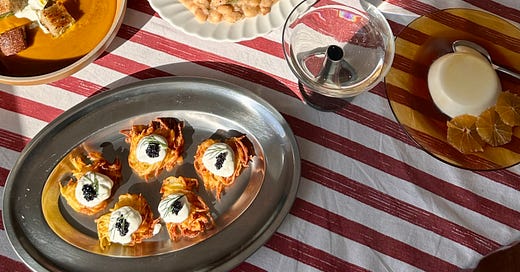



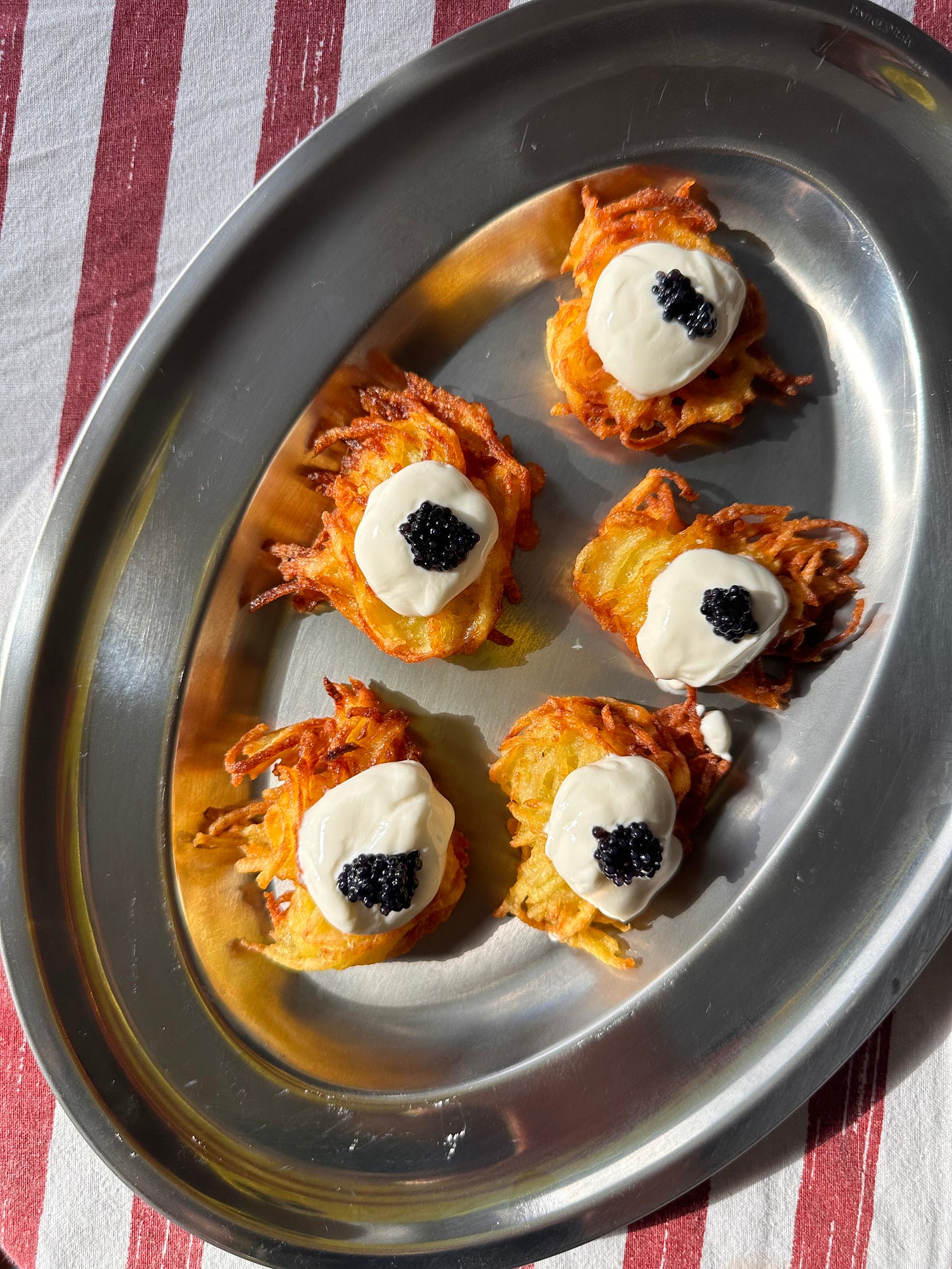
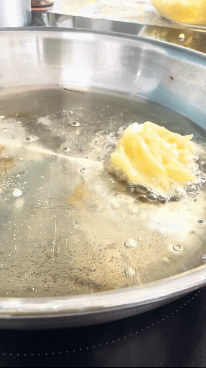
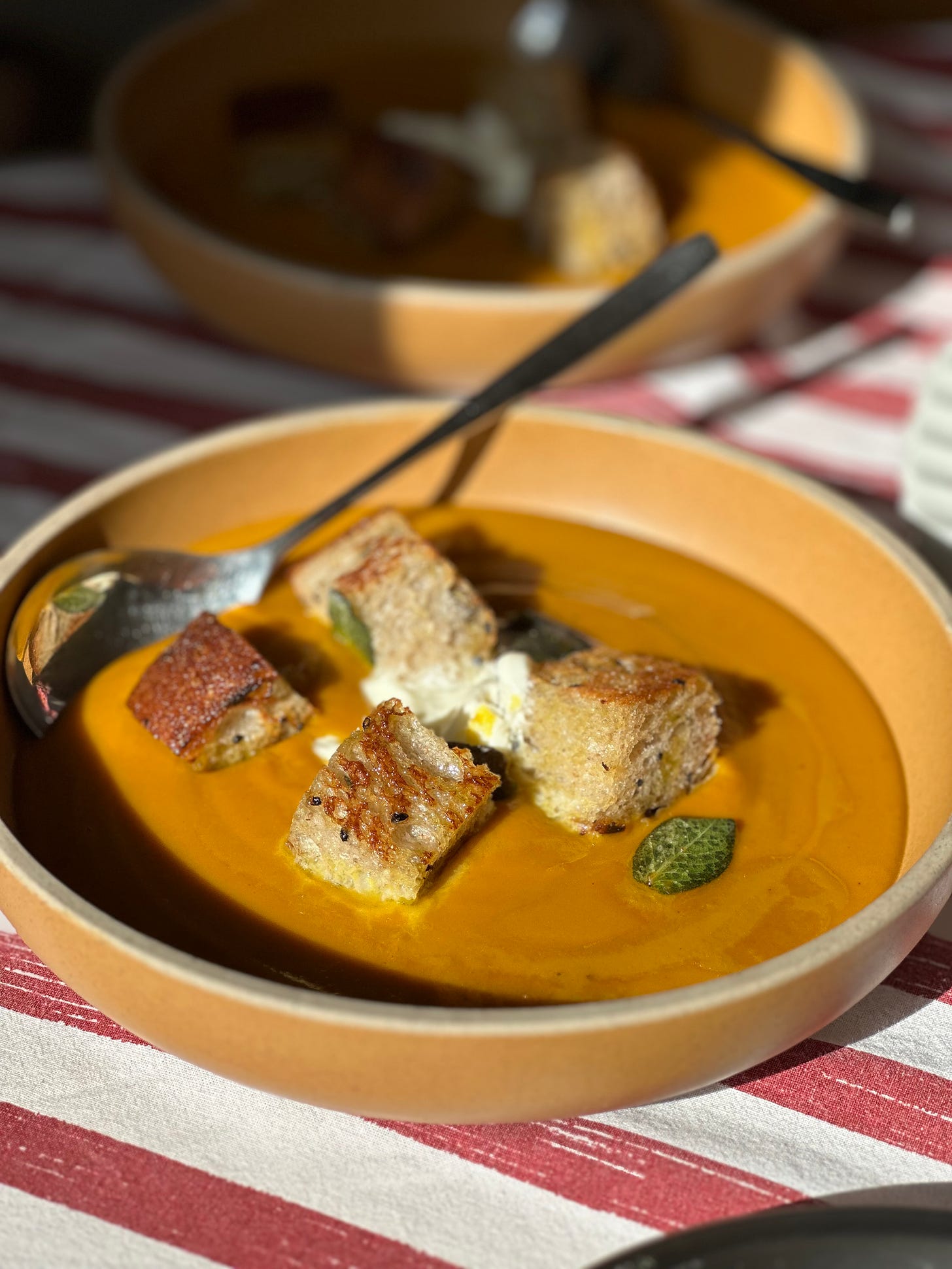
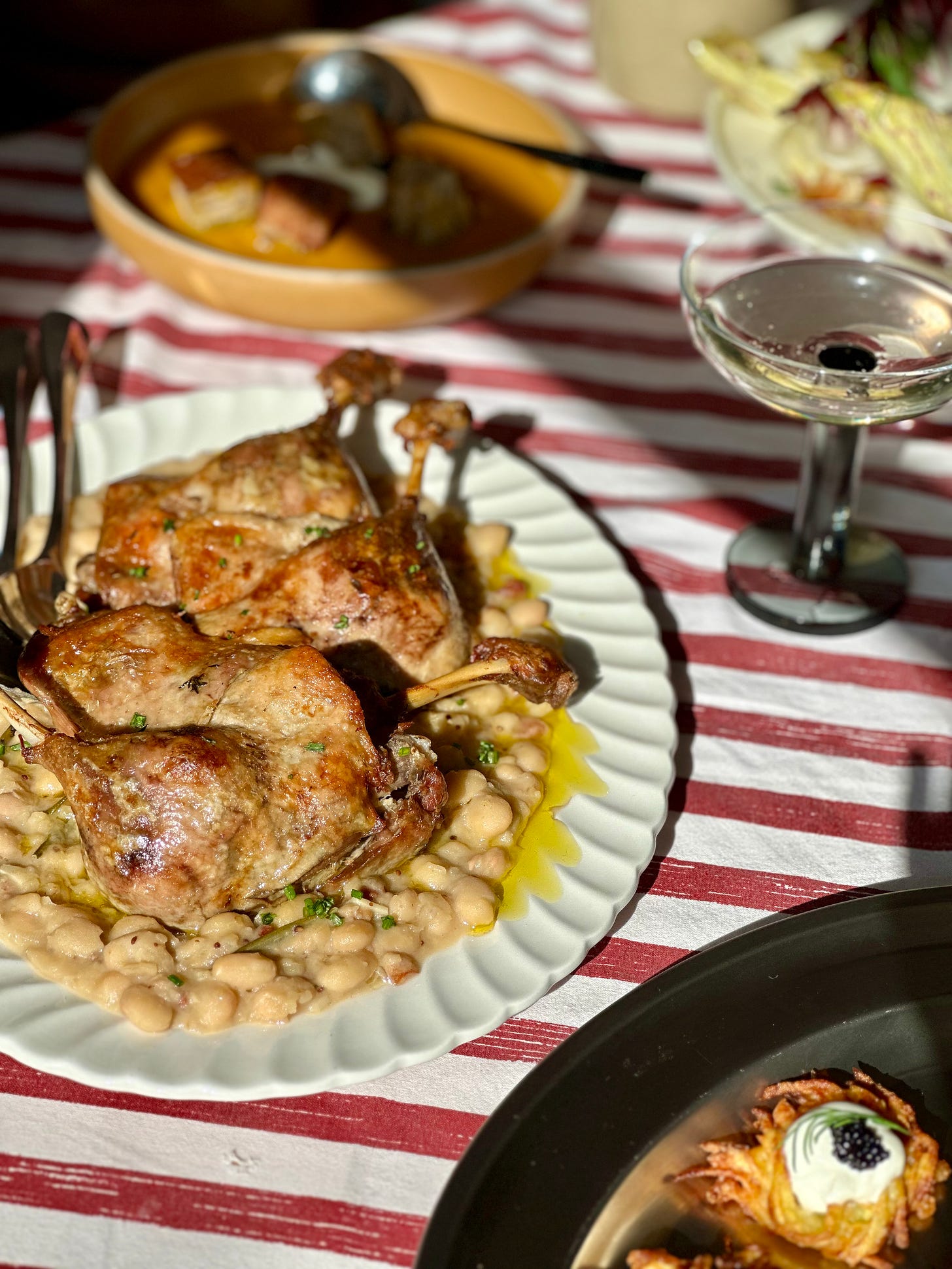
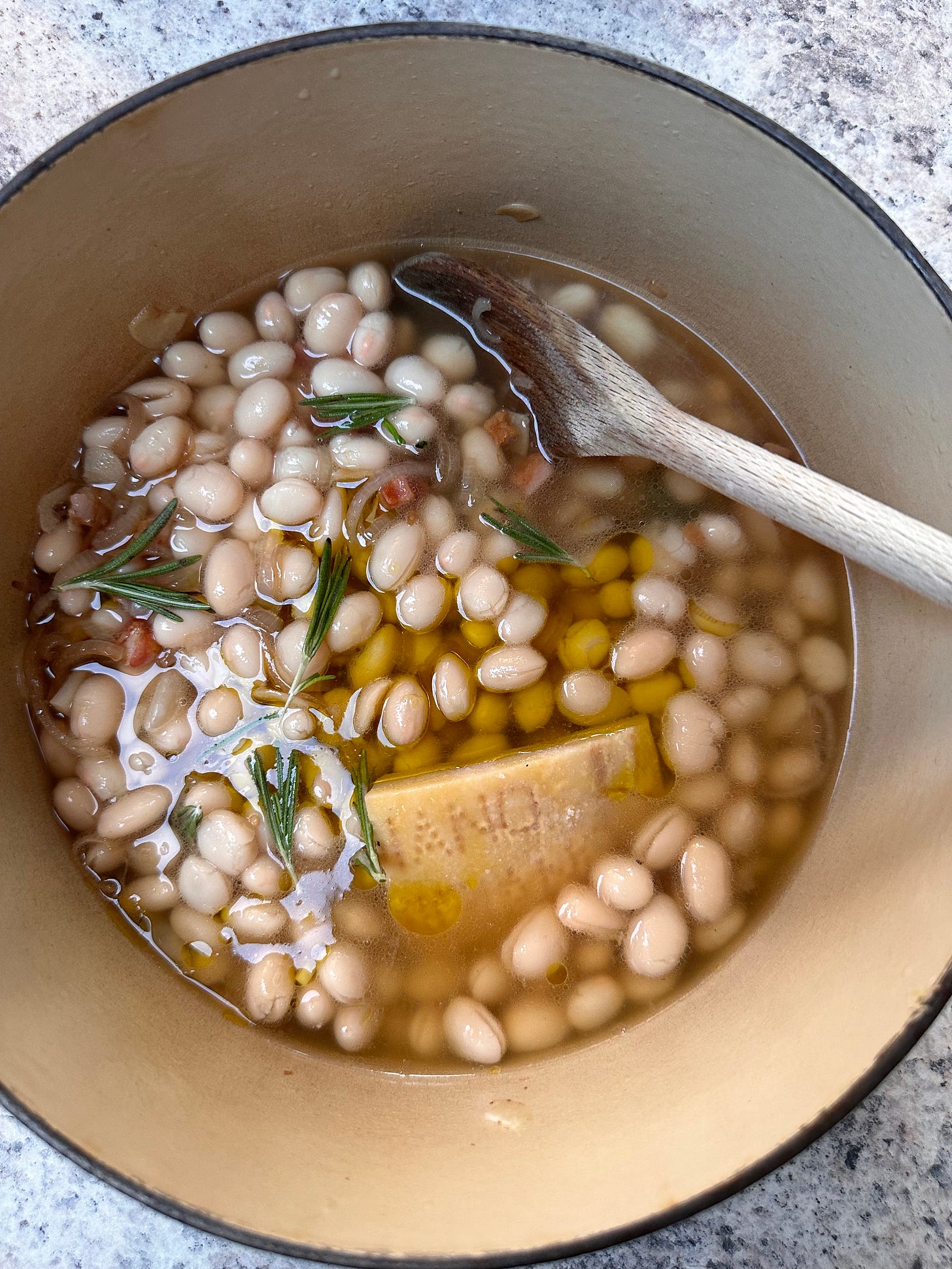
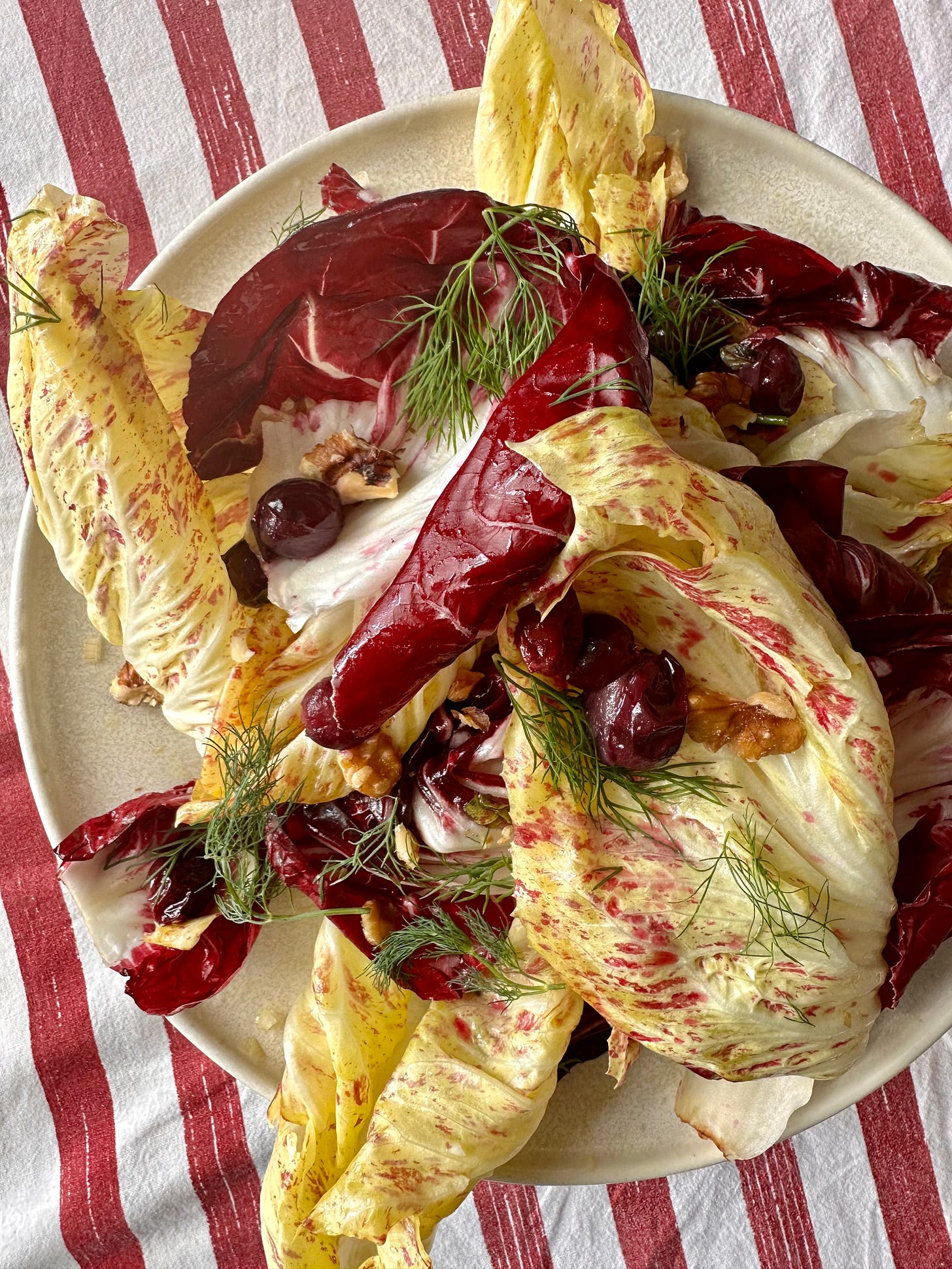
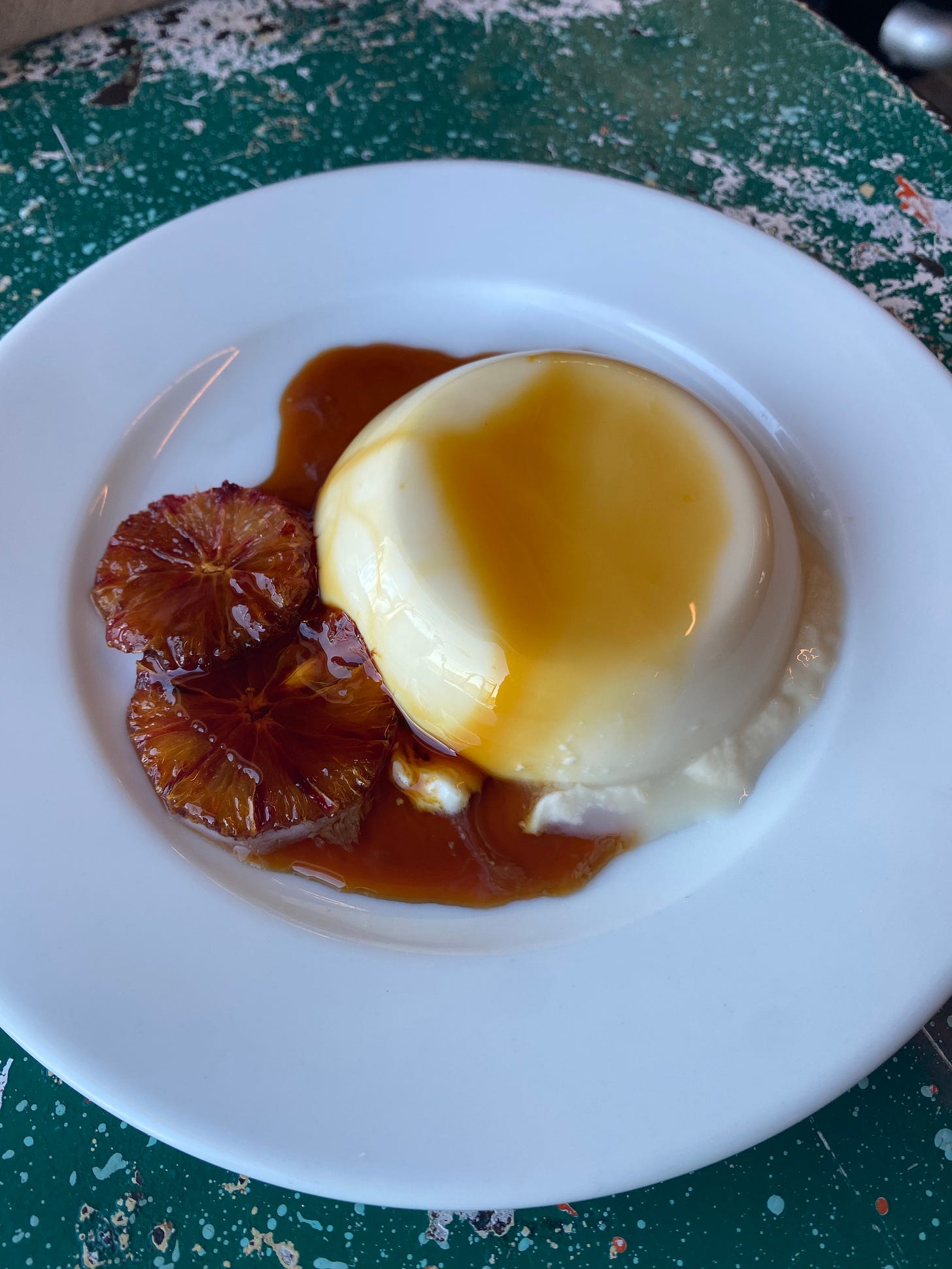
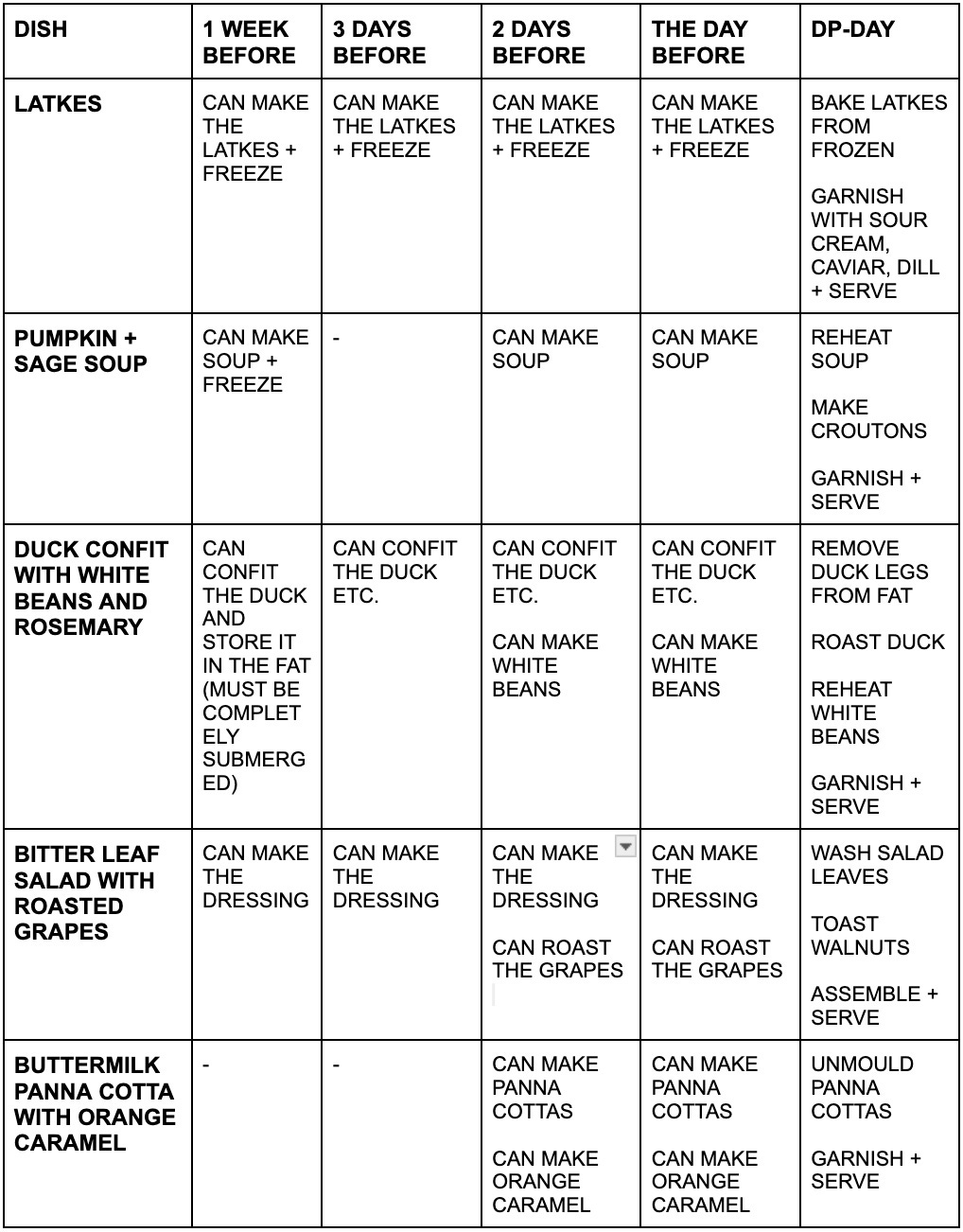
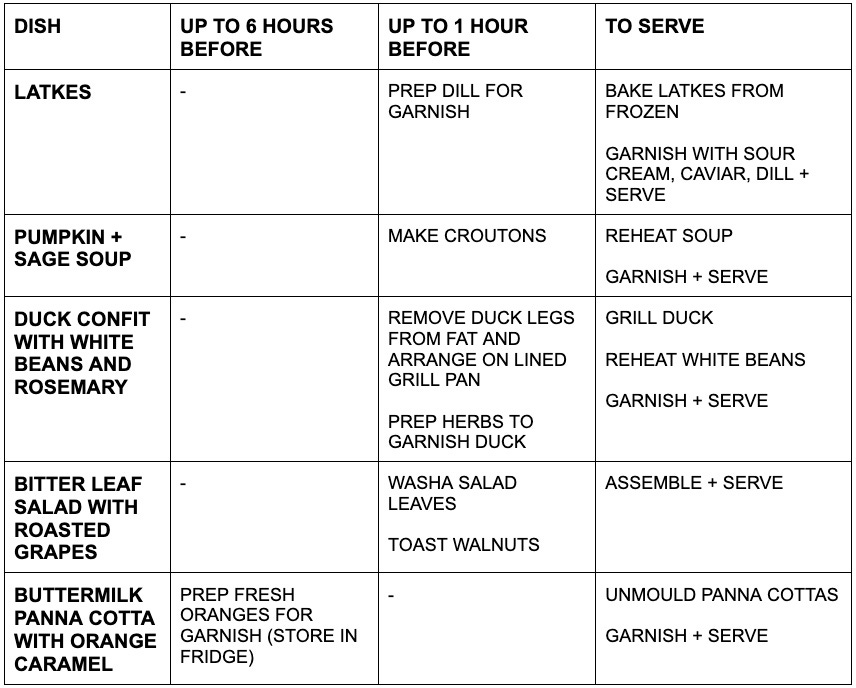
This menu sounds - and looks - ravishing. One small question, re gelatine: could you give the quantity in grammes as well, please? (I don’t know the size of sheets used here so it would be reassuring do know the weight).
Many thanks.